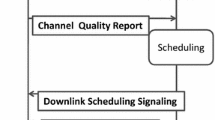Abstract
Interleaver centric systems have a significant role to play in fifth generation (5G) real-time communication. Flip Left–Right approach based Inverse Tree Interleavers (FLRITIs) are among one of the recently developed interleavers for these interleaver centric systems. During the real-time communication, interleaver assignment requests from multiple users often arrive at next generation NodeB (gNB) simultaneously. Therefore, a mechanism is essentially needed to handle these simultaneous interleaver assignment requests at the gNB. In this paper, an efficient mechanism to handle the simultaneous interleaver i.e. FLRITI assignment requests originated from different wireless transmit receive units is proposed. This mechanism helps the network in taking a correct logical decision based on pre-configured policy/policies while assigning correct sequence number and hence, the correct FLRITI to each 5G user from the inverse tree structure. The method is equally effective in all types of time-critical and non-time critical 5G communication scenarios e.g. Ultra reliable low latency communication 5G new radio, enhanced mobile broadband etc.











Similar content being viewed by others
Notes
The arrival time of both the requests are same, no decision can be made based on TOA. Check based on TOA is not required here; therefore skipped by the network.
References
Ping, L., Liu, L., Wu, K., & Leung, W. K. (2006). Interleave-division multiple-access. IEEE Transactions on Wireless Communication, 5(4), 938–947.
Yadav, M., Shokeen, V., & Singhal, P. K. (2017). Flip left right approach based inverse tree interleaver design for IDMA scheme. AEÜ International Journal of Electronics and Communications, 81, 182–191.
Yadav, M., Shokeen, V., & Singhal, P. K. (2019). Flip left-to-right approach based inverse tree interleavers for unconventional integrated OFDM-IDMA and SCFDMA-IDMA systems. Wireless Personal Communications, 105(3), 1009–1026.
Yadav, M., Gautam, P. R., Shokeen, V., & Singhal, P. K. (2017). Modern fisher-yates shuffle based random interleaver design for SCFDMA-IDMA system. Wireless Personal Communications, 97(1), 63–73.
Shokeen, V., Yadav, M., & Singhal, P. K. (2018). Comparative analysis of FLR approach based inverse tree and modern fisher-yates algorithm based random interleavers for IDMA systems. In IEEE 8th international conference on cloud computing, data science and engineering (Confluence)’18, Noida, India (pp. 457–452).
R1-1911355. Time and frequency interleaver for LTE-based 5G terrestrial broadcast. EBU, BBC, and IRT, 3GPP RAN WG1, #98bis, Chongqing, China, October 2019.
R1-1912331. CRBI-based interleaver for 5G terrestrial broadcasting. 3GPP RAN WG1, #99bis, Reno, USA. November 2019.
Shukla, M., Srivastava, V. K., & Tiwari, S. (2009). Analysis and design of optimum interleaver for iterative receivers in IDMA scheme. Wireless Communications and Mobile Computing, 9, 1312–1317.
Flynn, J. P., & Tankhilevich, B. G. (2011). Apparatus for dynamically configurable interleaver scheme using at least one dynamically changeable interleaving parameter. USPTO Patent No. US20080276138A1, Wideband Semiconductor, Inc.
Montero, R., Agraz, F., Pagès, A., & Spadaro, S. (2019). Actuation framework for 5G-enabled network slices with QoE/QoS guarantees. In IEEE 21st international conference on transparent optical networks (ICTON)’19, Angers, France (1-4).
Yaghoubi, F., et al. (2018). A techno-economic framework for 5G transport networks. IEEE Wireless Communications, 25(5), 56–63.
Gopal, R., & Benammar, N. (2018). Framework for unifying 5G and next generation satellite communications. IEEE Networks, 32(5), 16–24.
Author information
Authors and Affiliations
Corresponding author
Additional information
Publisher's Note
Springer Nature remains neutral with regard to jurisdictional claims in published maps and institutional affiliations.
Rights and permissions
About this article
Cite this article
Yadav, M., Singhal, P.K. Simultaneous Interleaver Assignment Requests Handling in Inverse Tree Interleaver Deployment Scenario for Multi-user 5G Communications. Wireless Pers Commun 118, 1129–1147 (2021). https://doi.org/10.1007/s11277-020-08062-y
Accepted:
Published:
Issue Date:
DOI: https://doi.org/10.1007/s11277-020-08062-y




